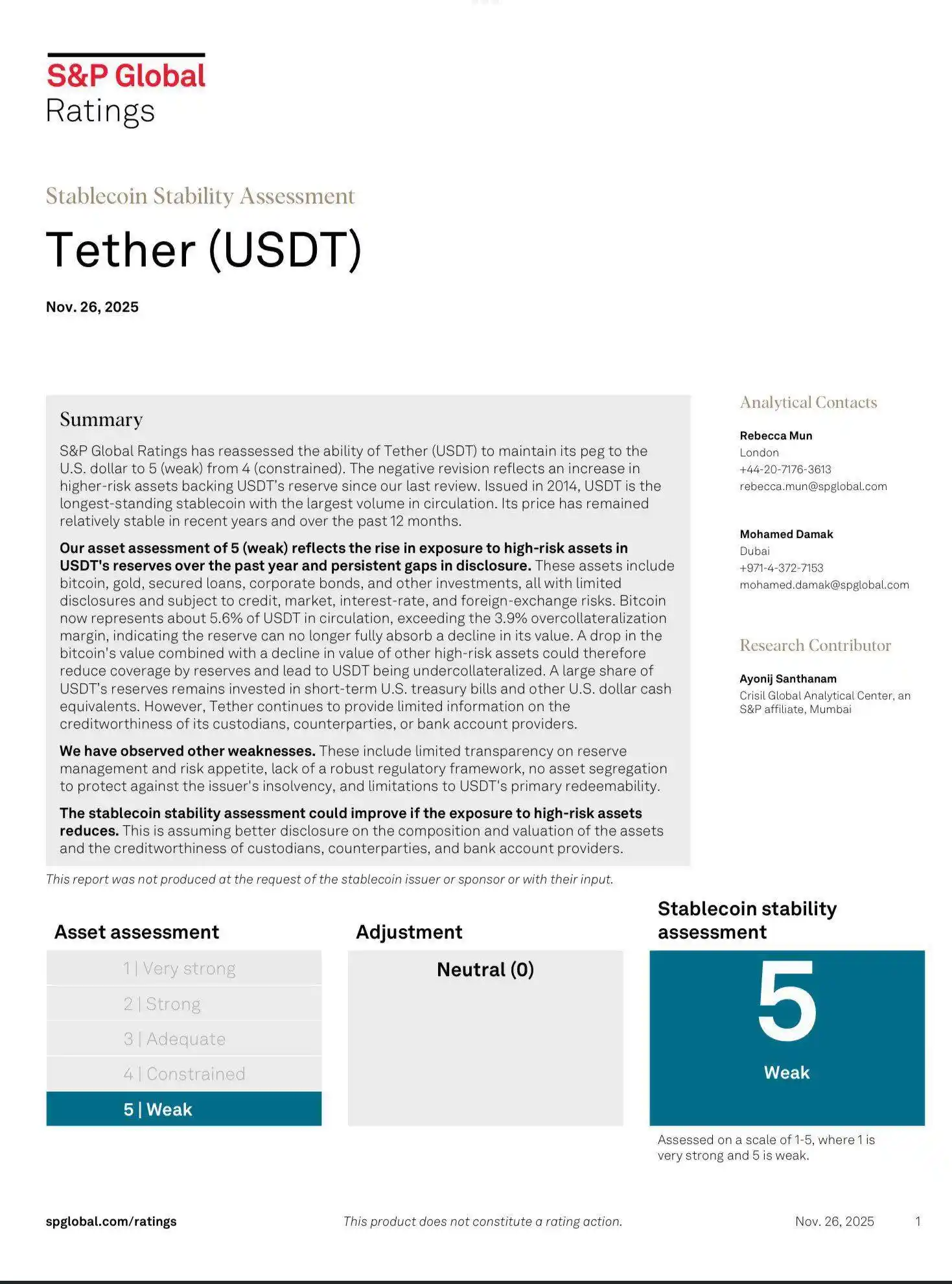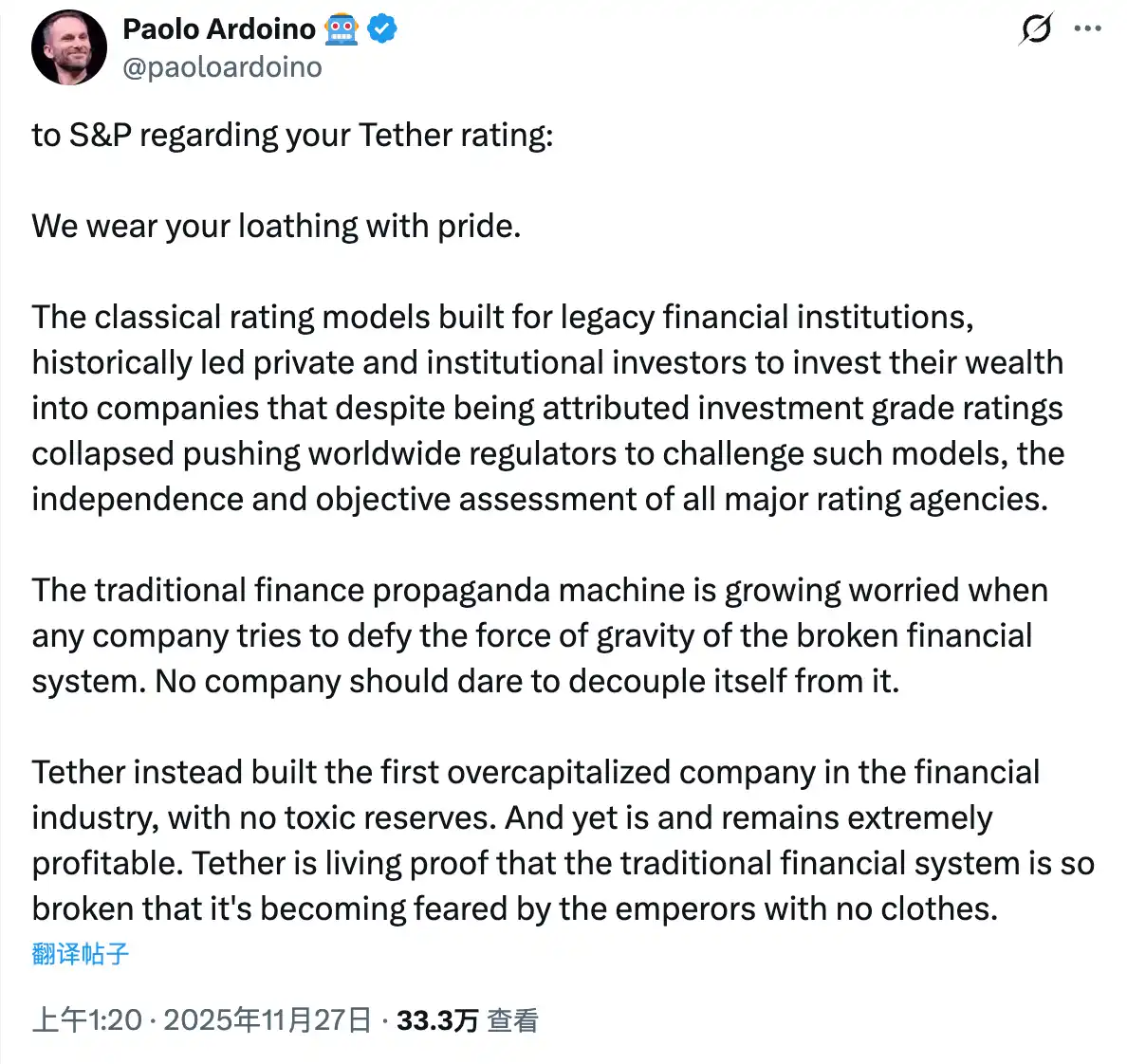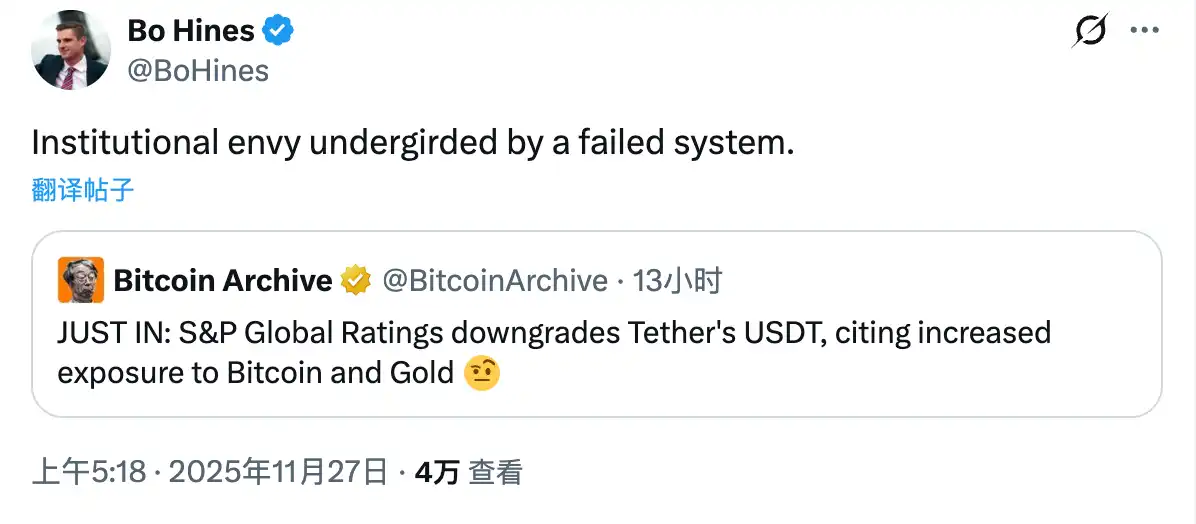Standard & Poor's Downgrades USDT to Lowest Rating, Controversy Surrounds Leading Stablecoin
Standard & Poor's has downgraded USDT to the lowest rating, citing high-risk reserves and insufficient disclosure as the main reasons, while centralized transparent stablecoins like USDC have received higher praise.
Original Article Title: "S&P Gives Tether a Poor Rating, Which Stablecoins Does It Favor?"
Original Article Author: Azuma, Odaily Planet Daily
On November 26th, U.S. Eastern Time, top rating agency S&P Global announced that it had downgraded the rating of stablecoin giant Tether (USDT) from "4" (Restricted) to "5" (Vulnerable), the lowest level in its rating system.
This comes after Strategy, when S&P once again gave a staggering negative rating to the industry leader.

S&P's Rating Criteria
S&P, along with Moody's and Fitch, is one of the world's three major rating agencies, and is currently recognized as one of the most authoritative credit rating agencies in the international financial market. According to S&P's official introduction, its stability assessment system for stablecoins aims to provide market participants with transparency on various stablecoin stabilities, and specifically analyzes their uncoupling risks.
Specifically, S&P's analytical approach consists of the following steps:
· First, an assessment of asset quality is conducted, including credit risk, market value, and custody risk;
· Subsequently, a further analysis is made on the over-collateralization requirements of major stablecoins and the extent to which the liquidation mechanism can mitigate these risks (light gray box in the diagram below);
· Considering these factors, S&P will assign asset quality scores ranging from 1 to 5 (Strong, Good, Adequate, Restricted, Vulnerable) to each stablecoin (black box in the diagram below);
· After completing the asset quality assessment, S&P will also consider governance mechanisms, legal and regulatory frameworks, redemption capabilities and liquidity, technology and third-party dependencies, historical records, and five additional dimensions (dark gray box in the diagram below);
· The pros and cons of these five dimensions will together form an overall risk assessment view, thus influencing the final scores of each stablecoin (red box in the diagram below).

Reasoning Behind the Rating of Tether (USDT)
In its announcement about the downgrade of Tether (USDT), Standard & Poor's stated that this downgrade reflects the increased presence of medium- to high-risk assets supporting USDT's reserves since the last evaluation, as well as ongoing concerns regarding Tether's disclosure practices.
Standard & Poor's further elaborated that the so-called high-risk assets include Bitcoin, gold, secured loans, corporate bonds, and other investments, all of which have limited disclosure and face credit, market, interest rate, and foreign exchange risks. Currently, Bitcoin accounts for approximately 5.6% of Tether's reserve value, exceeding Tether's own 3.9% overcollateralization ratio, indicating that other low-risk reserve assets are no longer sufficient to fully back USDT's value. If the value of BTC and other high-risk assets were to decline, it could weaken the coverage of USDT's reserves, potentially leading to undercollateralization of USDT. As for other low-risk reserve assets, a significant portion is invested in short-term U.S. Treasury bonds and other U.S. dollar cash equivalents; however, Tether has persistently had disclosure issues regarding custodians, counterparties, or banking providers.
Standard & Poor's also added that, in addition to the main reasons mentioned above, the agency believes that Tether (USDT) also faces issues such as limited transparency in reserve management and risk preferences, lack of a robust regulatory framework, lack of asset segregation to guard against issuer bankruptcy, and restrictions on USDT redeemability.
Concluding the rating, Standard & Poor's also mentioned the potential for a rating adjustment for Tether (USDT)—if the exposure to high-risk asset reserves decreases and Tether improves its disclosure practices, it could enhance the assessment of its stability.
Rating of Other Stablecoins
Aside from Tether, Standard & Poor's has also rated several mainstream stablecoins such as USDC, USDe, with the following specific results:
· Circle (USDC): 2 (Strong);
· Circle (EURC): 2 (Strong);
· First Digital USD (FDUSD): 4 (Restricted);
· TrueUSD (TUSD): 5 (Vulnerable);
· Gemini USD (GUSD): 2 (Strong);
· Paxos Standard (PAX):2 (Strong);
· EUR Coinvertible (EURCv):3 (Ample);
· TrustToken USD (TUSD):3 (Ample);
· Ethena (USDe):5 (Vulnerable);
· Sky Protocol (USDS/DAI):4 (Restricted);
· Frax (FRAX):5 (Vulnerable);
From the above chart, it is evident that Standard & Poor's (S&P) clearly favors centralized stablecoins with overcollateralization and high transparency (such as USDC), while holding a relatively pessimistic view towards mainstream decentralized stablecoins (such as USDe, USDS) — this is also understandable, as seen from the rating logic of the previous two sections, S&P tends to classify assets like BTC as high risk, which is often a significant part of the collateral for decentralized stablecoins.
Tether's Response
Following S&P's rating adjustment for Tether (USDT), Tether CEO Paolo Ardoino responded strongly on platform X, saying, "We take pride in your hatred."
Paolo Ardoino further stated that the classical rating models used by traditional financial institutions have led countless private and institutional investors to put their wealth into companies that, although investment-grade rated, ultimately collapsed. This has prompted global regulatory bodies to question the independence and objectivity of these models and even all major rating agencies. When companies attempt to break free from the flawed financial system's gravity, the traditional financial propaganda machine becomes increasingly fearful. There is no company that dares to attempt to break free from this system. Against this backdrop, Tether has built the first capitalized company in the financial industry, with no toxic asset reserves, and it remains highly profitable to this day. Tether's existence proves that the traditional financial system is riddled with holes, and even the "emperor with no clothes" is fearful.

Will This Impact USDT?
Looking back at S&P's rating description of Tether (USDT), apart from the changes in BTC reserve percentage, S&P has repeatedly mentioned Tether's disclosure issues.
Due to its offshore nature and some operational historical factors, Tether has always been accompanied by some controversies in terms of transparency. Compared to its biggest competitor, USDC, the lack of disclosure in reserves, audits, and other aspects for USDT is an objective fact. However, with its unparalleled liquidity conditions (especially since almost all CEXs use USDT as the base settlement currency), coupled with excellent historical performance and a strong financial position, the market still highly trusts and even relies on USDT — supported by a powerful network effect, USDT has always firmly held the throne in the stablecoin race.
As overseas influencer Novacula Occami commented: ".... the lack of disclosure has been a long-standing issue for Tether, but they are neither able nor willing to address it."
Obviously, the attitude of a mere rating agency is not enough to shake USDT's market position. However, it is worth noting that Tether has previously announced the launch of the stablecoin USAT for the U.S. market in December, and it has already been strictly regulated in terms of reserve status, regulatory registration, disclosure mechanisms, and redemption clauses through the GENIUS Act. These regulatory requirements align closely with S&P's rating standards. If Tether wants to smoothly promote USAT in the U.S. in the future, it may still need to consider S&P's rating to some extent.

Following Paolo Ardoino's strong response to S&P today, Bo Hines, the head of Tether's USAT business, also swiftly denounced "the institutional incompetence that breeds institutional jealousy." However, despite the denouncement, while Paolo Ardoino may not need to care about S&P, Bo Hines really needs to think about how to specifically address the issues mentioned by S&P.
Disclaimer: The content of this article solely reflects the author's opinion and does not represent the platform in any capacity. This article is not intended to serve as a reference for making investment decisions.
You may also like
Shiba Inu’s Focus on Privacy Aims to Draw DeFi Interest Amid Price Challenges
- Shiba Inu (SHIB) stabilizes near $0.00000851, with traders monitoring $0.000008390 support and $0.000008840 resistance amid a descending channel pattern since early 2025. - A 1.7% weekly gain contrasts with a 17.4% drop from its 14-day high, while $132.8M trading volume highlights uncertainty despite a privacy-focused Shibarium upgrade integrating Zama's FHE technology. - Technical indicators show fragile equilibrium, with bearish EMAs and $380K net outflows reinforcing distribution trends, though analys

Bitcoin News Update: Greenidge Transitions to AI as Bitcoin Mining Faces Rising Expenses and Regulatory Challenges
- Greenidge Generation , a Bitcoin miner, shifts to AI/HPC amid industry cost and regulatory pressures. - Bitcoin mining profitability declines as hashrate hits 1.16 ZH/s and hash prices fall below $35. - Companies like Bitfarms abandon Bitcoin for AI/HPC, while CleanSpark reports $766M mining revenue surge. - Regulatory scrutiny intensifies over foreign mining hardware, with BlockQuarry promoting domestic alternatives. - Energy costs and debt disputes force Tether to halt Uruguayan mining, highlighting se

Bitcoin News Update: Institutions Favor Bitcoin's Reliability as Altcoin Growth Slows
- Bitcoin's market dominance exceeds 54%, driven by waning altcoin momentum and institutional preference for stability. - Altcoin Season Index at 23 signals Bitcoin-centric trends as macroeconomic pressures and regulatory uncertainty weaken alternative cryptocurrencies. - Institutional investors prioritize Bitcoin's scalability and infrastructure, exemplified by Bhutan's Ethereum integration and Bitcoin Munari's fixed-supply presale model. - Analysts highlight Bitcoin's role as a macroeconomic barometer, w
MMT Token TGE: Is This the Dawn of a New Era for Digital Asset Foundations?
- MMT Token's 2025 TGE secured $100M valuation from Coinbase Ventures, OKX, and Jump Crypto, with 1330% price surge post-launch. - Momentum DEX on Sui reported $13B trading volume and $320M TVL, leveraging CLMM architecture and cross-chain RWAs for institutional appeal. - 55% of hedge funds now hold digital assets, driven by U.S. CLARITY Act and EU MiCA 2.0, as MMT's RWA focus bridges traditional and blockchain finance. - Despite macroeconomic risks like 34.6% post-TGE volatility, MMT's governance model an

